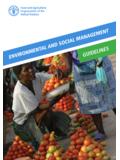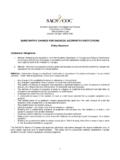Transcription of Farmer Field School Guidance Document
1 Farmer Field School Guidance Document Planning for quality programmes Plant Production and Protection Division Food and Agriculture Organization of the United Nations Viale delle Terme di Caracalla 00153 Rome, Italy This publication has received funding from the ISBN 978-92-5-109126-5 Farmer Field School . European Union through the Improved Global Governance for Hunger Reduction Programme . Guidance Document . FAO. The views expressed herein can in no way be taken to reflect the 9 7 8 9 2 5 1 0 9 1 2 6 5. official opinion of the European Union. I5296E/1 Planning for quality programmes Farmer Field School Guidance Document xiv Farmer Field School . Guidance Document . Planning for quality programmes Food and Agriculture Organization of the United Nations Rome, 2016.
2 The designations employed and the presentation of material in this information product do not imply the expression of any opinion whatsoever on the part of the Food and Agriculture Organization of the United Nations (FAO) concerning the legal or development status of any country, territory, city or area or of its authorities, or concerning the delimitation of its frontiers or boundaries. The mention of specific companies or products of manufacturers, whether or not these have been patented, does not imply that these have been endorsed or recommended by FAO in preference to others of a similar nature that are not mentioned. The views expressed in this information product are those of the author(s). and do not necessarily reflect the views or policies of FAO.
3 ISBN 978-92-5-109126-5. FAO, 2016. FAO encourages the use, reproduction and dissemination of material in this information product. Except where otherwise indicated, material may be copied, downloaded and printed for private study, research and teaching purposes, or for use in non-commercial products or services, provided that appropriate acknowledgement of FAO as the source and copyright holder is given and that FAO's endorsement of users' views, products or services is not implied in any way. All requests for translation and adaptation rights, and for resale and other commercial use rights should be made via request or addressed to FAO information products are available on the FAO website ( publications) and can be purchased through Cover photographs (clockwise from top left): FAO/Areepan Upanisakorn; FAO/Deborah Duveskog.
4 FAO/Francesca Mancini; Agrorural / MINAGRI. Graphic design: Anastasia Clafferty. Table of contents Foreword ..v Preface ..vii Acronyms and abbreviations ..xi 1. 2. Why Farmer Field schools?..5. Why are Farmer Field schools relevant?.. 6. Farmer Field schools in response to today's farming 9. National contextualization of Farmer Field schools .. 10. The Farmer Field School decision tree .. 12. 3. Key elements of Farmer Field Farmer Field School : basic learning cycle and follow-up 16. Non-formal adult education, adult learning, learning 16. Characteristics of the Farmer Field School basic learning 19. Farmer Field School implementation 21. Non-negotiable elements of quality Farmer Field 23. 4. Designing a Farmer Field School Time dimensions of Farmer Field School 28.
5 Assessing the local context .. 30. Establishing the necessary 30. Stakeholders and stakeholder analysis .. 30. Framing programme objectives .. 31. Defining the geographical scope .. 34. Taking stock of capacity 36. 38. 5. Developing human capacity for Farmer Field Farmer Field School programme managers .. 44. Farmer Field School master trainers .. 44. Farmer Field School mentors, Field coordinators or focal 46. Farmer Field School 46. 6. Defining the Farmer Field School learning Understanding the community's 52. Developing the Farmer Field School curriculum .. 53. Including life skills, gender equality and 56. 7. Monitoring, evaluation and continuous Concepts and objectives of monitoring, evaluation and 60. Monitoring, evaluation and learning as a continuous, participatory 60.
6 Results chain and indicators of a successful Farmer Field School .. 61. Main actors in monitoring, evaluation and 62. Developing a monitoring 64. Choosing appropriate monitoring and evaluation 65. Linking the monitoring of Farmer Field School groups and 68. 8. Impact Setting up the impact assessment 72. Who should design and carry out impact assessment?.. 72. Designing impact 73. Identifying 73. Choosing tools and methods to assess 74. Addressing stakeholder issues in impact assessment .. 74. 9. Budgeting for Farmer Field School The role of group contributions .. 82. Finance delivery systems .. 82. 10. Building on the basic Farmer Field School learning Expanded learning elements and follow up action .. 86. Facilitating the institutionalization of Farmer Field schools.
7 89. The role of 90. Key resources and bibliography ..93. Foreword Every day we learn more about the global challenges facing food production: global warming, extreme weather, intercontinental invasions by pests and diseases, land degradation and water loss from over-exploitation, and price volatility. Farming, fishing and agroforestry systems are becoming more complex, but we are also learning how local agro ecosystems provide the underlying services soil nutrient cycling, pest and disease regulation, water capture and storage, pollination, genetic resources conservation, coastal protection for aquatic species and from storms that enable farmers to adapt to those challenges. The Sustainable Development Goals (SDGs), approved in 2015 by the Member Countries of the UN, aim to achieve productive, inclusive and sustainable agriculture, while strengthening rural livelihoods and ensuring food and nutrition security for all, reducing pressures on natural resources and building resilience to climate change.
8 These represent very ambitious targets, which demand concerted efforts at global and national levels. But at the same time we know that the actual sustainability of production and natural resource use for present and future generations is in the hands and the heads of local farmers , fisher-folk and pastoralists. FAO is committed to support the more than 500 million family farmers , with special attention to rural women, to enable them to continue playing this essential role. farmers Field schools (FFS), FAO's front-line innovation, are amongst its most fundamental Field v contributions to fulfill this commitment. FAO has been incubating, nurturing and promoting Farmer Field Schools for over a quarter of a century.
9 FFS emerged during the same period as problems of climate change and accelerating international spread of pests; but they also evolved as our understanding of ecosystem services improved. So as we confront ever more complex global to national to local problems, we also understand much better how to build on local ecosystems to make agriculture and food production more sustainable. This movement has grown from the promotion within government extension programmes of a new paradigm of experiential, hands- on education and empowerment, to address complex production threats and a range of technical and livelihood issues, in both government and civil society programmes in over 90 countries. FFS. enable and empower smallholders, their families and rural communities to understand and respond to present challenges and make their own critical contributions to the attainment of SDGs.
10 FFS are earning growing support from partner governments, NGOs, researchers, international development and financing organizations, and social movements. There are now over 12 million FFS smallholder family Farmer graduates, but what drives the results is not the quantity of attendees but the empowering quality of the process and how it enables participants to continue to grow, using the new skills and knowledge. FFS provide structured opportunities and space where farmers , pastoralists and fisher-folk understand, co-create and adapt knowledge, science and technical tools; they are active participants in the process and they are respected. Their experience and thoughts are valued by the group and in their communities a new experience for many, particularly among the women participants.













